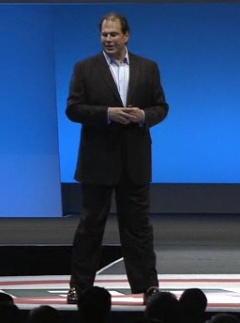Force.com 2 brings new clouds to Salesforce

Salesforce.com's transition from software-as-a-service to platform-as-a-service has taken a step forward with a major update to its Force.com developer platform.
The company introduced Force.com 2, updated with five tools for building applications for the cloud, on Wednesday at its Dreamforce 2010 developer event in San Francisco. Force.com 2 consists of a number of different features targeting business applications, web site development, enterprise Java and packaged application distribution.

Marc Benioff announced a range of cloud initiatives at the Dreamforce conference. Photo credit: Larry Dignan
Best considered an evolution of the company's existing platform, Force.com 2 is intended to make Salesforce more attractive to developers, said the company's chief executive Marc Benioff and platform and marketing chief George Hu, who outlined the product in a keynote presentation.
Hu described it as Salesforce.com's solution to what he called 'the IT debt problem', which is the backlog of application development at businesses. "The gap between what's available and what is needed is growing," he told the Dreamforce audience.
New features in Force.com 2 include Siteforce, a website platform with integrated content management and design and layout tools. Using Siteforce's support for component-based page layout, Hu demonstrated how developers can add social components to an existing web page, along with Siteforce's support for mobile devices.
Hu also showed the VMforce Java tools, which Salesforce has developed in conjunction with VMware. The tools allow developers to use the most popular Java environments, the Spring Framework and Eclipse IDE when building applications. VMforce is now in private beta and will move to general availability in the first half of 2011, according to Hu.
Salesforce's original developer platform, now renamed AppForce, also gains new features. Among these are support for rules-based content sharing, as well as significantly improved performance.
The other two new services are ISVForce, for building multi-tenant cloud applications, and the Heroku Ruby cloud application platform. This last technology comes from Salesforce's purchase of platform-as-a-service (PaaS) vendor Heroku, which Benioff announced during the keynote. The Heroku acquisition adds cloud-hosted development using the popular Ruby language to Salesforce's set of development tools and platforms.
Benioff described Heroku as the answer to the question of: "How do we open the platform, how do we extend it, give our customers more languages, more support?". He added that Heroku would continue to operate as an independent platform in its own environment.
Developers looking for a cloud platform have had to choose between open and trusted platforms, Heroku's chief executive Byron Sebastian suggested during the announcement. "This [move is] bringing Ruby together with Salesforce's trust," he said.
While the move to a cloud platform was the main theme of the Dreamforce 2010 keynote, Benioff also demonstrated another set of cloud applications that add new features to the company's software-as-a-service (SaaS) portfolio.
At the event, Benioff also unveiled RemedyForce, a cloud service arising from a new partnership with BMC. The IT service management platform replicated much of the functionality of BMC's Remedy in Salesforce's cloud. Intended to help businesses using the Force.com platform and Salesforce.com to support users, RemedyForce includes a configuration management database, collaboration tools based on Salesforce.com's Chatter, and a set of analytic and reporting tools.